display MITSUBISHI LANCER 2014 8.G Service Manual
[x] Cancel search | Manufacturer: MITSUBISHI, Model Year: 2014, Model line: LANCER, Model: MITSUBISHI LANCER 2014 8.GPages: 434, PDF Size: 57.5 MB
Page 153 of 434

Electronically controlled 4WD system (if so equipped) 5-86 Features and controls
5
The drive mode is displayed as an interrupt display on the information screen in the multi-information display when the drive mode is switched.After a few seconds, the information screenreturns from the drive mode display to the previous screen.
N00549400017
Normally the indicator illuminates when theignition switch is turned to the āONā posi- tion, and then the drive mode is displayed afew seconds after the engine is started. The status of each drive mode display is as follows.
1- 2WD 2- 4WD AUTO3- 4WD LOCKDrive mode
Display
Ty p e 1
Ty p e 2
2WD
4WD AUTO
4WD LOCK
CAUTIONļ¬ Do not operate the drive mode-selector with the front wheels spinning on a snowy road or in similar conditions. The vehicle couldlunge in an unexpected direction. ļ¬ Driving on dry, paved roads in ā4WD LOCKā mode causes increased fuel con- sumption, noise, and premature tire wear.ļ¬ Do not drive with the tires spinning in ā2WDā mode. Doing so could generate heat in the drive-system components.NOTE
ļ¬ The drive mode can be switched while driv- ing or stopped.
Drive mode indicator
Ty p e 1Drive mode
Display
Ty p e 1
Ty p e 2
Ty p e 2Drive mode
Drive mode indicator
ā4WDā indi-
cator
āLOCKā indicator
2WD OFF OFF
4WD AUTO ON OFF4WD LOCK ON ON
Page 154 of 434

All-wheel driving operation Features and controls 5-87
5
N00530600169
Full-time 4WD vehicles are propelled by engine power distributed constantly andappropriately to all 4 wheels. Not only does this ensure enhanced handling on dry, paved roads but also permits bettertraction when driving on slippery, wet orsnow-covered roads and when moving out of mud. These vehicles, however, are not designedfor off-road use, and are unsuitable for driving on bumpy ground that may cause excessive strain.
Full-time 4WD vehicles
should be driven only under the same condi- tions as are suitable for ordinary front-wheel drive vehicles. Electronically controlled 4WD system vehi- cles are propelled by engine power distrib- uted constantly and appropriately to all 4 wheels. Not only does this ensure enhanced handling on dry, paved roads but also permits better
CAUTIONļ¬ If the selected drive mode indicator is blink- ing, the vehicle switches automatically to front-wheel drive in order to protect the drive-system components, and drive mode selection is no longer po
ssible with the drive
mode-selector. The warning display is also displayed in the information screen in the multi-informationdisplay. Reduce speed, and if the indicator goes out after driving a while, resume driving asbefore. If the indicator continues blinking for more than about 5 minutes, have the vehicle inspected at an authorized Mitsubishi Motorsdealer or a repair f
acility of your choice as
soon as possible.
Type 1 Type 2
CAUTIONļ¬ The warning display on the information screen in the multi-information display, a problem has occurred with the electronically controlled 4WD system and the safety device has activated. Have an inspection made byan authorized Mitsubishi Motors dealer or a repair facility of your choice as soon as pos- sible.
Type 1 Type 2
CAUTIONļ¬ Always use tires of the same size, type, and brand that have no wear differences. Using tires that differ in size, type, brand, or wear amount may activate the protection of thedrive-system components, causing the drive mode in ā4WD AUTOā mode to lock or the ā4WDā and āLOCKā indicators to blinkalternately.
All-wheel driving operation For vehicles with full-time 4WD For vehicles with electronically controlled 4WD system
Page 155 of 434
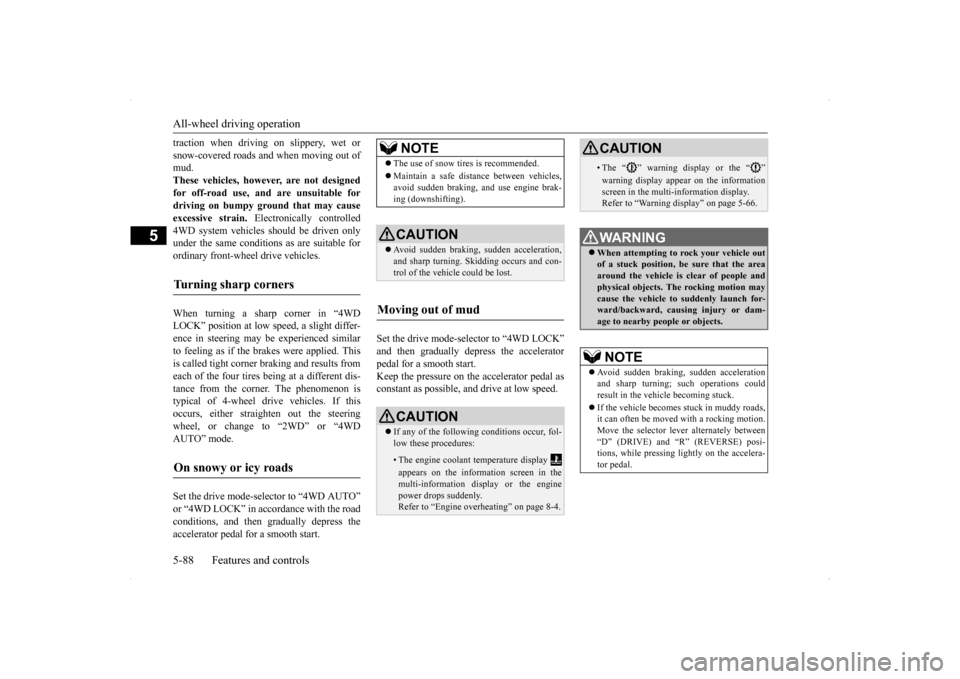
All-wheel driving operation 5-88 Features and controls
5
traction when driving on slippery, wet or snow-covered roads a
nd when moving out of
mud. These vehicles, however, are not designedfor off-road use, and are unsuitable for driving on bumpy ground that may cause excessive strain.
Electronically controlled
4WD system vehicles should be driven only under the same conditions as are suitable for ordinary front-wheel drive vehicles. When turning a sharp corner in ā4WD LOCKā position at low speed, a slight differ- ence in steering may be experienced similarto feeling as if the brakes were applied. This is called tight corner braking and results from each of the four tires being at a different dis-tance from the corner. The phenomenon is typical of 4-wheel drive vehicles. If this occurs, either straig
hten out the steering
wheel, or change to ā2WDā or ā4WD AUTOā mode. Set the drive mode-selector to ā4WD AUTOā or ā4WD LOCKā in accordance with the road conditions, and then gradually depress theaccelerator pedal for a smooth start.
Set the drive mode-selector to ā4WD LOCKā and then gradually depress the accelerator pedal for a smooth start. Keep the pressure on the accelerator pedal asconstant as possible, and drive at low speed.
Turning sharp corners On snowy or icy roads
NOTE
ļ¬ The use of snow tires is recommended. ļ¬ Maintain a safe distance between vehicles, avoid sudden braking, and use engine brak- ing (downshifting).CAUTIONļ¬ Avoid sudden braking, sudden acceleration, and sharp turning. Skidding occurs and con- trol of the vehicle could be lost.
Moving out of mud
CAUTIONļ¬ If any of the following conditions occur, fol- low these procedures:ā¢ The engine coolant temperature display appears on the information screen in the multi-information display or the engine power drops suddenly. Refer to āEngine overheatingā on page 8-4.
ā¢ The ā ā warning display or the ā ā warning display appear on the information screen in the multi-information display. Refer to āWarning displayā on page 5-66.WA R N I N Gļ¬ When attempting to rock your vehicle out of a stuck position, be sure that the area around the vehicle is clear of people and physical objects. The rocking motion may cause the vehicle to suddenly launch for- ward/backward, causing injury or dam-age to nearby people or objects.NOTE
ļ¬ Avoid sudden braking, sudden acceleration and sharp turning; such operations couldresult in the vehicle becoming stuck. ļ¬ If the vehicle becomes stuck in muddy roads, it can often be moved with a rocking motion. Move the selector lever alternately between āDā (DRIVE) and āRā (REVERSE) posi-tions, while pressing
lightly on the accelera-
tor pedal.CAUTION
Page 158 of 434
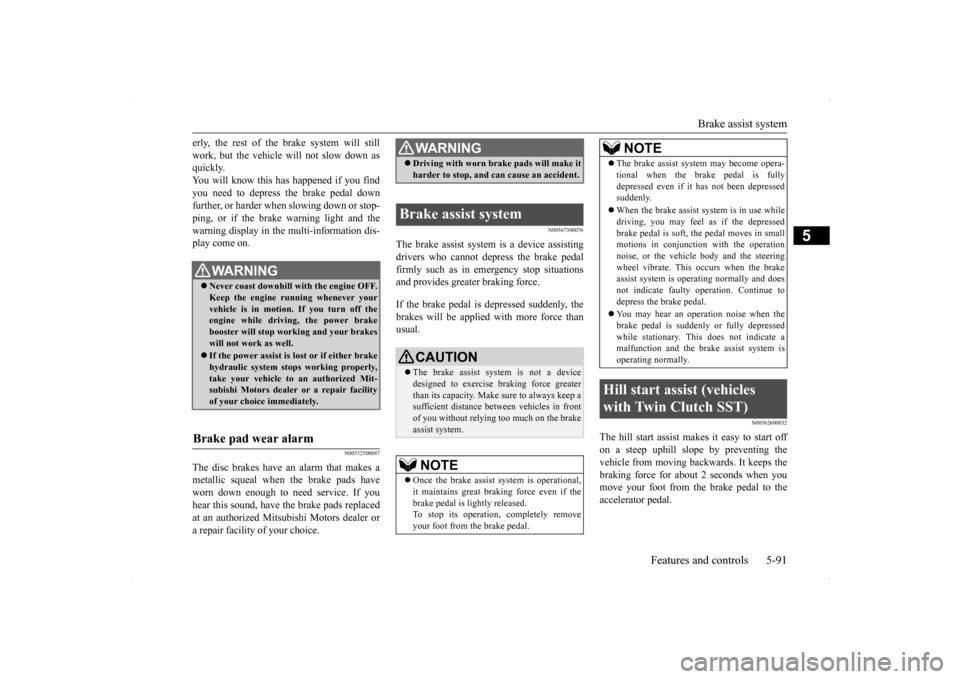
Brake assist system
Features and controls 5-91
5
erly, the rest of the br
ake system will still
work, but the vehicle will not slow down as quickly. You will know this has happened if you findyou need to depress the brake pedal down further, or harder when slowing down or stop- ping, or if the brake warning light and thewarning display in the multi-information dis- play come on.
N00532500087
The disc brakes have an alarm that makes ametallic squeal when the brake pads have worn down enough to need service. If youhear this sound, have the brake pads replaced at an authorized Mitsubishi Motors dealer or a repair facility of your choice.
N00567300076
The brake assist system is a device assisting drivers who cannot depress the brake pedal firmly such as in emergency stop situationsand provides greater braking force. If the brake pedal is depressed suddenly, the brakes will be applied with more force than usual.
N00562600032
The hill start assist makes it easy to start off on a steep uphill slope by preventing thevehicle from moving back
wards. It keeps the
braking force for about 2 seconds when you move your foot from the brake pedal to theaccelerator pedal.
WA R N I N Gļ¬ Never coast downhill with the engine OFF. Keep the engine running whenever your vehicle is in motion. If you turn off the engine while driving, the power brakebooster will stop working and your brakes will not work as well.ļ¬ If the power assist is
lost or if either brake
hydraulic system stops working properly, take your vehicle to an authorized Mit-subishi Motors dealer or a repair facility of your choice immediately.
Brake pad wear alarm
WA R N I N Gļ¬ Driving with worn brake pads will make it harder to stop, and can cause an accident.
Brake assist system
CAUTIONļ¬ The brake assist system is not a device designed to exercise braking force greaterthan its capacity. Make sure to always keep a sufficient distance between vehicles in front of you without relying too much on the brakeassist system.NOTE
ļ¬ Once the brake assist system is operational, it maintains great braking force even if the brake pedal is lightly released. To stop its operation, completely removeyour foot from the brake pedal.
ļ¬ The brake assist system may become opera- tional when the brake pedal is fully depressed even if it has not been depressed suddenly. ļ¬ When the brake assist system is in use while driving, you may feel as if the depressed brake pedal is soft, the pedal moves in smallmotions in conjunction with the operation noise, or the vehicle body and the steering wheel vibrate. This occurs when the brakeassist system is operating normally and does not indicate faulty operation. Continue to depress the brake pedal. ļ¬ You may hear an operation noise when the brake pedal is suddenly or fully depressedwhile stationary. This does not indicate a malfunction and the brake assist system is operating normally.
Hill start assist (vehicles with Twin Clutch SST)
NOTE
Page 159 of 434
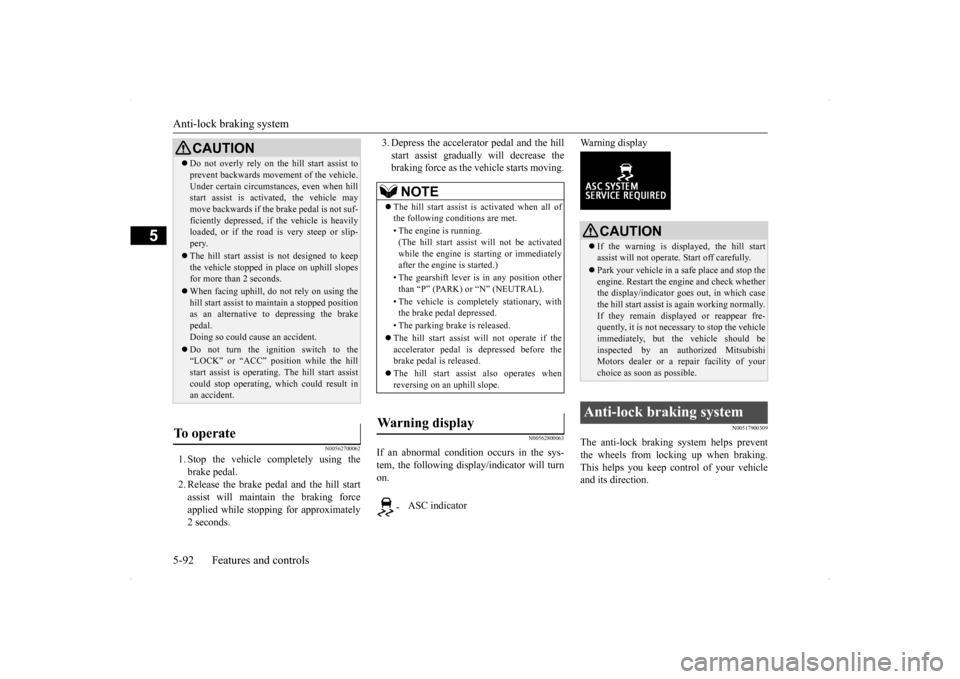
Anti-lock braking system 5-92 Features and controls
5
N00562700062
1. Stop the vehicle completely using the brake pedal.2. Release the brake pedal and the hill start assist will maintain the braking force applied while stopping for approximately2 seconds.
3. Depress the accelerator pedal and the hill start assist gradually will decrease the braking force as the vehicle starts moving.
N00562800063
If an abnormal condition occurs in the sys- tem, the following display/indicator will turnon.
Warning display
N00517900309
The anti-lock braking system helps prevent the wheels from locking up when braking.This helps you keep c
ontrol of your vehicle
and its direction.
CAUTIONļ¬ Do not overly rely on the hill start assist to prevent backwards movement of the vehicle. Under certain circumstances, even when hill start assist is activated, the vehicle may move backwards if the brake pedal is not suf-ficiently depressed, if the vehicle is heavily loaded, or if the road is very steep or slip- pery.ļ¬ The hill start assist is not designed to keep the vehicle stopped in place on uphill slopesfor more than 2 seconds.ļ¬ When facing uphill, do
not rely on using the
hill start assist to maintain a stopped position as an alternative to depressing the brake pedal.Doing so could cause an accident.ļ¬ Do not turn the ignition switch to the āLOCKā or āACCā position while the hill start assist is operating. The hill start assist could stop operating, which could result inan accident.
To operate
NOTE
ļ¬ The hill start assist is activated when all of the following conditions are met. ā¢ The engine is running. (The hill start assist will not be activated while the engine is starting or immediatelyafter the engine is started.) ā¢ The gearshift lever is in any position other than āPā (PARK) or āNā (NEUTRAL). ā¢ The vehicle is completely stationary, with the brake pedal depressed. ā¢ The parking brake is released.ļ¬ The hill start assist will not operate if the accelerator pedal is depressed before thebrake pedal is released. ļ¬ The hill start assist also operates when reversing on an uphill slope.
Warning display
-
ASC indicator
CAUTIONļ¬ If the warning is displayed, the hill start assist will not operate. Start off carefully.ļ¬ Park your vehicle in a safe place and stop the engine. Restart the engine and check whether the display/indicator goes out, in which case the hill start assist is
again working normally.
If they remain displayed or reappear fre- quently, it is not necessary to stop the vehicle immediately, but the vehicle should beinspected by an authorized Mitsubishi Motors dealer or a repair facility of your choice as soon as possible.
Anti-lock braking system
Page 160 of 434

Anti-lock braking system
Features and controls 5-93
5
ļ¬ When using the anti-lock brakes (sudden braking), steering is slightly different from normal driving conditions. Use thesteering wheel carefully. ļ¬ Always keep a safe distance from the vehicle in front of you. Even if your vehi-cle is equipped with the anti-lock braking system, leave a greater braking distance when:ā¢ Driving on gravel or snow-coveredroads. ā¢ Driving on uneven road surfaces. ļ¬ Operation of anti-lock braking system is not restricted to situations where brakes are applied suddenly. This system may also prevent the wheels from lockingwhen you drive over manholes, steel roadwork plates, road markings, or any uneven road surface. ļ¬ When the anti-lock braking system is in use, you may feel the brake pedal vibrat- ing and hear a unique sound. You mayalso feel as if the pedal resists being pressed. In this situation, simply hold the brakepedal down firmly. Do not pump the brake, which will result in reduced braking performance.
N00531600573
Warning light Warning display type 1 Warning display type 2 If there is a malfunction in the system, the anti-lock braking system warning light willcome on and the warning display will appearon the information screen in the multi-infor- mation display. Under normal conditions, the anti-lock brak-ing system warning light only comes on when the ignition switch is turned to the āONā position and goes off a few seconds later.
Driving hints
CAUTIONļ¬ The anti-lock braking system cannot prevent accidents. It is your responsibility to take safety precautions and to drive carefully. ļ¬ To prevent failure of the anti-lock braking system, be sure all four wheels and tires are the same size and the same type.ļ¬ Never install a limited s
lip differential as the
ABS may not function normally. Please consult an authorized MitsubishiMotors dealer.NOTE
ļ¬ After your vehicle is driven a short distance after starting the engine, you will hear thesound coming from the engine compartment. These are the normal sounds the anti-lock braking system makes when performing aself-check. It does not indicate a malfunc- tion. ļ¬ The anti-lock braking system can be used after the vehicle has reached a speed over approximately 6 mph (10 km/h). It stopsworking when the vehicle slows below approximately 3 mph (5 km/h).
Anti-lock braking system warn- ing light / display
Page 161 of 434

Anti-lock braking system 5-94 Features and controls
5
N00531700503
ļ¬ Avoid hard braking and high-speed driv- ing. Stop the vehicle in a safe place.Test the system by restarting the engine and driving at a speed
of about 12 mph
(20 km/h) or higher.If the warning light / display then remain off during driving, there is no problem. However, if the warning light / display donot disappear, or if they come on again when the vehicle is driven, have the vehi- cle checked by an authorized MitsubishiMotors dealer or repair facility of your choice as soon as possible.
Warning light
Warning display type 1 Warning display type 2 The anti-lock braking system and brake force distribution function may not work, so hard braking could make the vehicle unstable.Avoid hard braking and high-speed driving. Stop the vehicle in a safe place and contact an authorized Mitsubishi Motors dealer or repairfacility of your choice.
CAUTIONļ¬ Any of the following warning light/display behavior indicates that the anti-lock braking system is not functioning and only the stan- dard brake system is working. (The standard brake system will still work properly.) If thishappens, take your vehicle to an authorized Mitsubishi Motors dealer or a repair facility of your choice as soon as possible.ā¢ When the ignition switch is in the āONāposition, the warning light does not comeon or it remains on and does not go offā¢ The warning light comes on while drivingā¢ The warning display appears while driving
If the warning light / display comes on while driving If only the anti-lock braking sys- tem warning light / display comes on If the anti-lock braking system warning light / display and brake warning light / display come on at the same time
Page 162 of 434
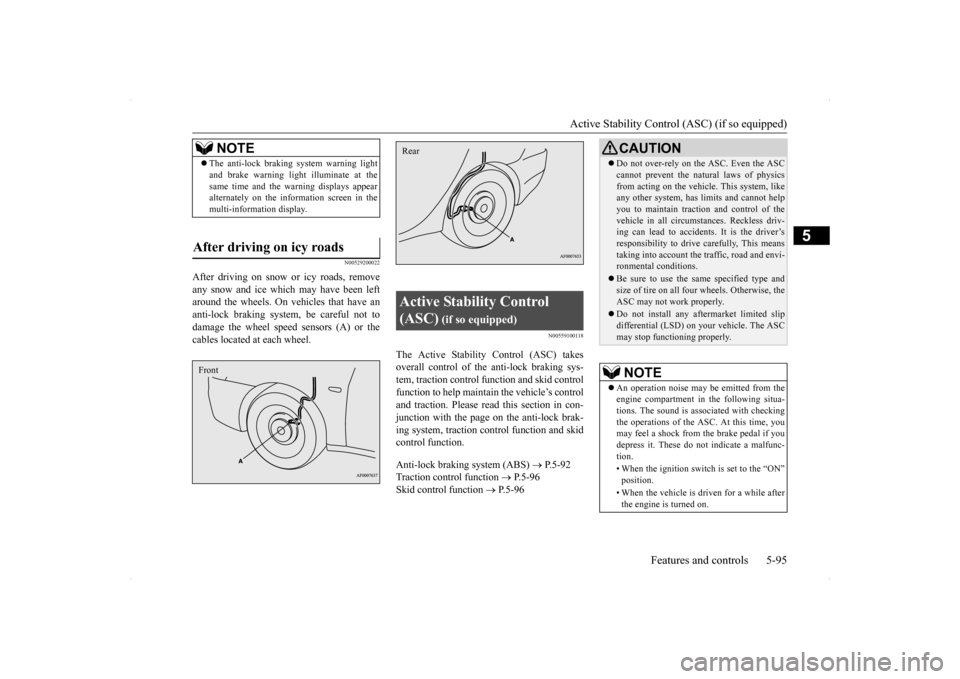
Active Stability Control (ASC) (if so equipped)
Features and controls 5-95
5
N00529200022
After driving on snow or icy roads, remove any snow and ice which may have been left around the wheels. On vehicles that have an anti-lock braking system, be careful not todamage the wheel speed sensors (A) or the cables located at each wheel.
N00559100118
The Active Stability Control (ASC) takesoverall control of the anti-lock braking sys- tem, traction control function and skid controlfunction to help maintain the vehicleās controland traction. Please read
this section in con-
junction with the page on the anti-lock brak- ing system, traction control function and skidcontrol function. Anti-lock braking system (ABS)
ļ® P.5-92
Traction control function
ļ® P.5-96
Skid control function
ļ® P.5-96
NOTE
ļ¬The anti-lock braking system warning light and brake warning light
illuminate at the
same time and the warning displays appear alternately on the information screen in the multi-information display.
After driving on icy roads Front
Active Stability Control (ASC)
(if so equipped)
Rear
CAUTIONļ¬ Do not over-rely on the ASC. Even the ASC cannot prevent the natural laws of physics from acting on the vehicle. This system, like any other system, has limits and cannot help you to maintain traction and control of thevehicle in all circumstances. Reckless driv- ing can lead to accidents. It is the driverās responsibility to drive carefully, This meanstaking into account the traffic, road and envi- ronmental conditions.ļ¬ Be sure to use the same specified type and size of tire on all four wheels. Otherwise, the ASC may not work properly.ļ¬ Do not install any aftermarket limited slip differential (LSD) on your vehicle. The ASCmay stop functioning properly.NOTE
ļ¬ An operation noise may be emitted from the engine compartment in the following situa-tions. The sound is associated with checking the operations of the ASC. At this time, you may feel a shock from the brake pedal if youdepress it. These do not indicate a malfunc- tion. ā¢ When the ignition switch is set to the āONā position. ā¢ When the vehicle is driven for a while after the engine is turned on.
Page 163 of 434

Active Stability Control (ASC) (if so equipped) 5-96 Features and controls
5
N00559200034
On slippery surfaces, the traction control function prevents the drive wheels from spin-ning excessive, thus helping the vehicle to start moving from a stop
ped condition. It also
provides sufficient driving force and steeringperformance as the vehicle turns while press- ing the acceleration pedal.
N00559300035
The skid control function is designed to help the driver maintain control of the vehicle onslippery roads or during rapid steering
maneuvers. It works by controlling the engine output and the brake on each wheel.
N00559400179
The ASC is automatically activated when the ignition switch is turned to the āONā posi- tion. You can deactivate the system by press-ing down the āASC OFFā switch for 3 seconds or longer. When the ASC is deactivated, the dis- play/indicator will turn on. To reactivate the ASC, momentarily press the āASC OFFā switch ; the display/indicator is turned off.
N00559500183
ļ¬ When the ASC is activated, you may feel a vibration in the vehicle body or hear a whin- ing sound from the engine compartment. This indicates that the system is operating normally. It does not indicate a malfunction. ļ¬ When the anti-lock braking system warning light is illuminated, the ASC is not active.
Traction control function
CAUTIONļ¬ When driving a vehicle on a snowy or icy road, be sure to install snow tires and drivethe vehicle at moderate speeds.
Skid control function
NOTE
NOTE
ļ¬ The skid control function operates at speeds of about 9 mph (15 km/h) or higher.
āASC OFFā switch
CAUTIONļ¬ For safety reasons, the āASC OFFā switch should be operated when your vehicle is stopped. ļ¬ Be sure to keep the ASC on while driving in normal circumstances.NOTE
ļ¬ Using the āASC OFFā switch turns off both the skid control function and the tractioncontrol function. ļ¬ When moving out of mud, sand or fresh snow, pressing the accelerator pedal may not allow the engine speed to increase. In such situations, temporarily turning off ASC withthe āASC OFFā switch will make it easier to move out your vehicle. ļ¬ If you continue to press the āASC OFFā switch after the ASC is turned off, the āmis- taken operation protection functionā willactivate and the ASC will turn back on.
ASC operation display or ASC OFF display
-
ASC operation display/ASC indicator The display/indicator will blink whenthe ASC is operating.
Page 164 of 434
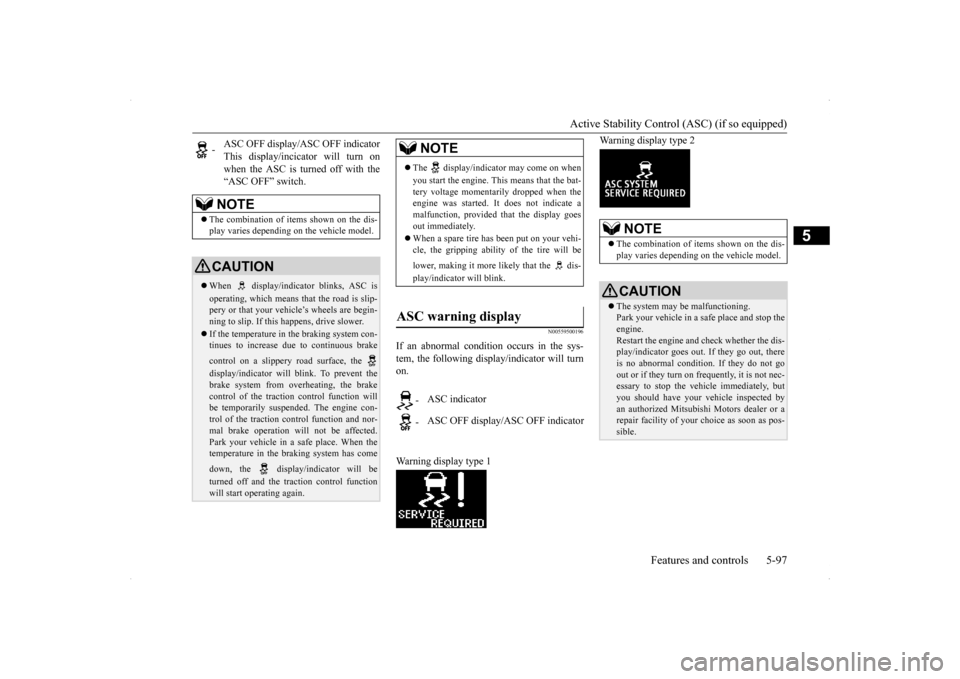
Active Stability Control (ASC) (if so equipped)
Features and controls 5-97
5
N00559500196
If an abnormal condition occurs in the sys- tem, the following display/indicator will turn on. Warning display type 1
Warning display type 2
-
ASC OFF display/ASC OFF indicator This display/incicator will turn onwhen the ASC is turned off with the āASC OFFā switch.NOTE
ļ¬ The combination of items shown on the dis- play varies depending on the vehicle model.CAUTIONļ¬ When display/indicator blinks, ASC is operating, which means that the road is slip- pery or that your vehicleās wheels are begin-ning to slip. If this happens, drive slower.ļ¬ If the temperature in the braking system con- tinues to increase due to continuous brake control on a slippery road surface, the display/indicator will blink. To prevent the brake system from overheating, the brake control of the traction control function willbe temporarily suspended. The engine con- trol of the traction control function and nor- mal brake operation will not be affected. Park your vehicle in a safe place. When the temperature in the braking system has come down, the display/indicator will be turned off and the traction control function will start operating again.
NOTE
ļ¬ The display/indicator may come on when you start the engine. This means that the bat- tery voltage momentarily dropped when the engine was started. It does not indicate amalfunction, provided that the display goes out immediately. ļ¬ When a spare tire has been put on your vehi- cle, the gripping ability of the tire will be lower, making it more likely that the dis- play/indicator will blink.
ASC warning display
-
ASC indicator
-
ASC OFF display/ASC OFF indicator
NOTE
ļ¬ The combination of items shown on the dis- play varies depending on the vehicle model.CAUTIONļ¬ The system may be malfunctioning. Park your vehicle in a safe place and stop the engine. Restart the engine and check whether the dis- play/indicator goes out. If they go out, there is no abnormal condition.
If they do not go
out or if they turn on frequently, it is not nec- essary to stop the vehicle immediately, but you should have your vehicle inspected byan authorized Mitsubishi Motors dealer or a repair facility of your
choice as soon as pos-
sible.